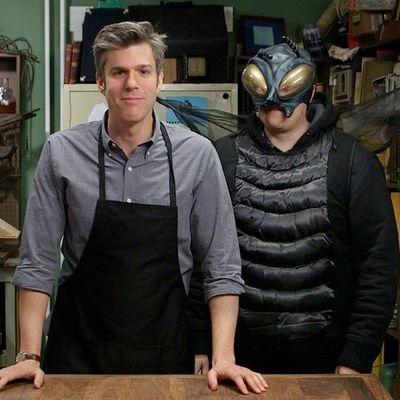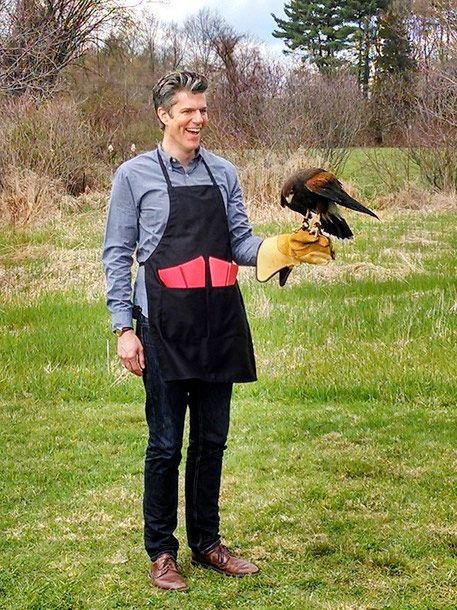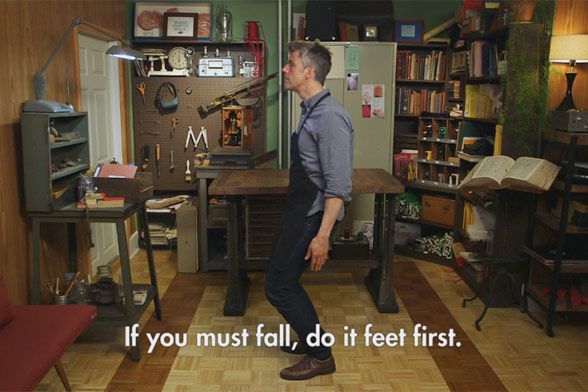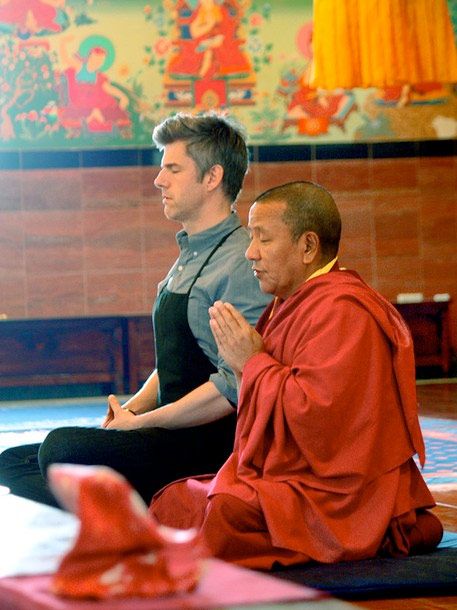
This article originally ran last week, but we’re republishing it to coincide with tonight’s first-season finale.
For the past year, I’ve been working on a how-to show for National Geographic called Going Deep With David Rees. As co-creator and host, I learned how to make ice cubes, how to tie my shoes properly, how to throw a paper airplane, and how to do a bunch of other cool things — but I also learned, for the first time, how to make a TV show. If you’d like to make a TV show of your own, follow these simple steps and think of me when you win your Emmy.
WEAR THE SAME THING EVERY DAY
Ralph Waldo Emerson said, “a foolish consistency is the hobgoblin of little minds,” which is probably why he never got a TV deal. When it comes to wardrobe, a foolish consistency is your best friend. We shot our episodes simulaneously and out of order, which meant wardrobe continuity would’ve been a colossal headache. To make our lives easier, the producers and I decided I would wear the same outfit in every scene. We bought four identical pairs of pants, four identical button-down shirts, four identical V-neck undershirts, four identical pairs of black socks, and one black apron — until we misplaced it, at which point we bought up every black apron in North America. The black apron served two purposes: It protected my limited supply of shirts and it gave me an air of unimpeachable authority. (People will follow a man in a black apron anywhere.) Wearing the same outfit every day meant we could focus on other concerns, like what to order for lunch.

DRINK WITH YOUR CREW
I was the least experienced person on our show by a factor of 20. Everyone else had worked on multiple reality programs. Since our show was a little weird, and we were kind of figuring it out as we went along, it took some time for the crew and the producers and I to all get on the same page — some of the crew seemed a little confused about the point of our show at first. But everything clicked after we met Dr. Shovel. For our episode “How to Dig a Hole,” we visited an ergonomics professor who specializes in tools used at Penn State. (He was the shovel consultant for my Party Hole.) That night, the crew and I rendezvoused at a local bar. We got to talking about what makes something a hole: Is a hula hoop a hole? Is the top of your shoe a hole? What about a cereal bowl? By the end of the night, everyone was yelling at each other about holes, which is when I said to myself: “Now we all understand what this show is about.” I didn’t realize it at the time, but many TV hosts don’t hang out with their crews; they retire to their hotel rooms and do God knows what while the crew bonds with each other over drinks. Socializing with your crew allows you to share your vision with them, and hopefully get them a little more invested in this big project you’re all working on — even if they’re completely wrong about what makes something a hole. (By the way, this emotional investment in the ontology of holes ran pretty hot until the day we actually filmed me digging my Party Hole.)
SAVE MONEY: SHOOT IN YOUR HOUSE
If you’ve watched our show, you’ve seen shots of me talking to camera in a cluttered workshop. That is my living room. Professional TV studios are very expensive; cheaper to just drill into your living-room ceiling and mount a few lights. Filming in your house has additional advantages: It cuts down on your commute; it’s easier to source props (why send a PA to Walmart to buy a wooden spoon when there’s one in your kitchen?); you know the best local restaurants for lunch; the bathroom has your favorite brand of hand soap. And best of all, during breaks, you can go upstairs and take a nap in your actual bed, rather than on some random studio floor. (NOTE: This tip may not work if you’re making Downton Abbey or Battlestar Galactica.)

MEMORIZE A POEM ABOUT YOUR SHOW
Once production begins, you’ll be overwhelmed with logistical demands and tonal decisions and pressure from higher-ups and withering self-doubt. In the midst of all this, it can be hard to remember why you wanted to make your show in the first place. You can’t see the forest because you’re constantly being jabbed in the eyes with trees. This is why you should memorize a poem that sums up the goal of your show at least one month before shooting begins. In times of stress or confusion, this poem will serve as a motivational mnemonic device. My inspiration for Going Deep was a poem by Gerard Manley Hopkins called “Pied Beauty.” It celebrates the awkward, unglamorous, mundane things surrounding us, which was the goal of our show. By reciting this poem to myself whenever I felt overwhelmed, I was able to stay focused on the big picture and make decisions that served said big picture. If you can’t find a poem that encapsulates the spirit of your show, commission one from a local bohemian.

DON’T STAY UP TOO LATE IN MISSOULA
Our last out-of-town shoot was at the Fire Sciences Laboratory in Missoula, Montana, where we learned about the fluid dynamics that influence how fires spread. After a long day of filming, the crew and I decided to celebrate a job well done. We sat in the parking lot of Missoula’s fanciest hotel and drank a lot of beer. We had an argument about whether the Rolling Stones were better than Led Zeppelin. (Anyone who believes that doesn’t understand what rock music is.) Then we went to eat dinner. Then we went to a bar. Then we played pool. Then I put more money into a jukebox than I ever had before. Then we went to a second bar, where we met some nice locals. Then we went to a third bar, where we met some not-quite-as-nice locals. Then we went to a late-night diner, where I think I ate chicken-fried steak with Thousand Island dressing. At this point, we had about an hour before we were supposed to leave for the airport to catch our 5:30 a.m. flight. My field producer, an experienced television professional, asked permission to sleep in the hotel lobby so he wouldn’t miss his ride. I made the amateur’s mistake of lying down in my hotel room, convinced my phone’s alarm would wake me up. (I hadn’t planned on the phenomenon of “Spontaneous Chicken-Fried-Beer-Induced Deafness.”) The next thing I remember was our production assistant standing over my bed, pleading for me to pack my bag so I wouldn’t miss the flight. My irresponsible behavior inconvenienced our team and caused undue panic in our production assistant, for which I apologize. Missoula’s seductions are dangerous; be wary and approach with caution.
DON’T QUIT YOUR DAY JOB
Like every other career in post-industrial America, making a TV show offers little in the way of job stability. You are subject to the whims of the marketplace, and as such, you should act as if doom is lurking around every corner. If possible, keep an alternative source of income in play while making your TV show. Before working on Going Deep, I had a pencil-sharpening business that paid pretty well. I decided to keep my online store open during most of the production. Even though demand for my pencils has dropped significantly in the past two years, just knowing that orders continued to trickle in made me less nervous about having all my income tied up in one basket.
Going Deep With David Rees — which Vulture’s Margaret Lyons proclaimed to be “joyous and educational in addition to being hilarious” — airs its season finale tonight at 10 p.m. on National Geographic Channel. Archived episodes are available to stream for free on Hulu.




